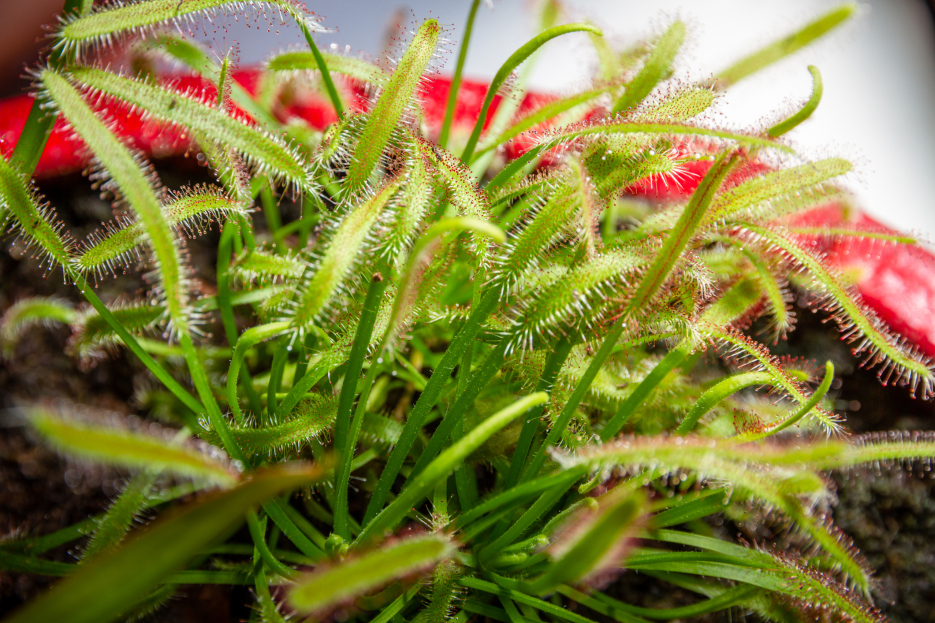
Drosera, commonly known as sundews, is a genus of carnivorous plants that attract attention with their unique, sticky, glandular hairs that capture and digest insects. These plants are native to a wide range of environments, from tropical rainforests to temperate grasslands, and are known for their ability to thrive in nutrient-poor soils. While sundews are fascinating and relatively easy to care for, they do have specific needs that must be met to thrive in a home or garden. Here’s a comprehensive guide on how to care for Drosera plants.
Drosera plants thrive in bright, direct sunlight. To ensure your sundew plant gets the light it needs, place it near a south or west-facing window where it can receive several hours of sunlight each day. These plants need at least 6 hours of direct sunlight to stay healthy and strong.
If you are growing your Drosera indoors and natural light is insufficient, you can supplement with a grow light to mimic the sunlight they would naturally receive. Be sure to provide 12-16 hours of light per day when using artificial lighting, and keep the light source 6-12 inches above the plant to prevent overheating or burning.
Sundews have specific water requirements. Since they are native to areas with nutrient-poor, acidic soils, it is important to use distilled water, rainwater, or purified water for watering. Tap water contains minerals that can harm these plants, as they are not adapted to handle the salts and minerals in regular tap water.
Water your Drosera by either placing it in a shallow dish of water or by using the tray method—where you add water to the bottom of the pot and allow the plant to absorb it through the drainage holes. Keep the soil consistently moist but not waterlogged. Always ensure the plant's roots and soil have access to water, but avoid allowing the plant to sit in standing water for long periods, which could lead to rot.
Sundews thrive in acidic, nutrient-poor soil. Use a special carnivorous plant mix or create your own by combining sphagnum moss, perlite, and sand. Avoid using regular potting soil, as it contains too many nutrients that can damage the plant.
A pot with good drainage is essential to prevent root rot. Plastic pots are ideal for Drosera because they help retain moisture better than clay pots. Be sure to use a pot that’s not too large for the plant's current size, as too much soil can retain excess moisture and lead to waterlogging.
Drosera plants are tropical or temperate species, and they thrive in warm temperatures and high humidity. They generally prefer temperatures between 70-90°F (21-32°C) during the growing season and 60-70°F (15-21°C) during the winter months.
These plants require high humidity to flourish, making them ideal for humid environments like bathrooms or terrariums. If you’re growing them indoors in a drier climate, consider using a humidifier or placing the plant in a clear plastic dome or a terrarium to maintain the high moisture levels they need. You can also place the plant on a shallow tray filled with pebbles and water to help increase humidity around it.
Drosera plants are carnivorous and obtain most of their nutrients from trapping and digesting insects. In their natural environment, they catch a variety of bugs, such as flies, ants, and spiders, using their sticky, glandular leaves.
When grown indoors, sundews can be fed small insects, such as flies or gnats, although they don’t need to be fed regularly. If you cannot provide live insects, you can occasionally feed them with freeze-dried bloodworms or insect-based food, available in pet stores. Simply place the food on the sticky glands of the plant, and the plant will digest it over time.
It’s important to avoid fertilizing your sundew with typical fertilizers. They are adapted to obtain nutrients from insects rather than soil, and traditional fertilizers will harm the plant.
Drosera plants generally don’t require much pruning, but it’s important to remove any dead or dried leaves and flower stalks to maintain the plant’s health and appearance. You can gently pinch off any dead growth using clean scissors or your fingers. Be sure to handle the plant with care, as its sticky leaves can trap dirt or debris.
If your Drosera begins to outgrow its pot, you may need to repot it into a larger container. This will ensure the plant has enough space to grow and its roots aren’t cramped.
Unfortunately, Drosera plants are not pet-friendly. While they are not toxic to pets, the sticky glandular hairs can cause irritation to animals if they come into contact with the plant. Additionally, if a pet ingests parts of the plant, they may experience stomach upset. Always keep Drosera plants out of reach of pets to prevent accidental ingestion or contact with the sticky leaves.